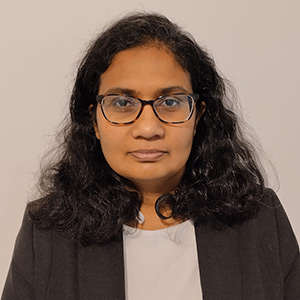Biography
I obtained my BSc Hons degree in Physics from the University of Jaffna, Sri Lanka in 2008, and my MSc by Research and PhD in Condensed Matter Physics from the University of Nottingham in 2012 and 2015, respectively. I received the EMRS Young Scientist Award in 2012. My areas of expertise are semiconductor physics, material science, and nanotechnology. My PhD project focussed on the fabrication of nanoscale current channels in dilute nitride III-N-V semiconductor compounds. At the end of my PhD, I changed my focus to the emerging new class of 2D materials. I gained 4.5 years of postdoctoral experience, 3 years at the University of Nottingham and 1.5 years at the University of Manchester.
I joined Keele University as a Lecturer in October 2019 and was promoted to Senior Lecturer in May 2024. Since I joined Keele, I have developed my independent research group in experimental 2D materials. My group’s research is focused on understanding the fundamental properties and applications of novel 2D materials. My research is supported by a Royal Society Research grant to understand the feasibility of III-VI van der Waals layered materials for flexible and wearable devices, a British Council Researcher Links Climate Change Workshop Grant to grow metal chalcogenides for sodium ion battery anodes, a Royal Society Short Industry Fellowship to study the surface and interface science of 2D materials using Kelvin probe force microscopy, and an EPSRC grant to synthesis smart electrodes for energy storage devices.
For further information please see my personal webpage of Dr Nilanthy Balakrishnan.
Research and scholarship

I am interested in studying the fundamental properties and applications of novel 2D materials. My research focuses on the production, characterization and exploitation of 2D materials, especially III-VI van der Waals layered materials. I am collaborating with the University of Nottingham, the University of Manchester and the National Physics Laboratory for various projects.
Synthesis
I have successfully developed a physical vapour deposition method to grow beta-In2Se3 on different substrates (SiO2, mica and graphite) and different In-Se compounds on GaSe crystal (N. Balakrishnan et al., 2016, 2018). Currently I am focussing to develop different band alignment and potential profiles by growing III-VI layers on different layered semiconductors. By combining materials with different band gap energies enable to fabricate different optoelectronic devices, including multi-colour solar cells.
Optoelectronics
The integration of 2D layered semiconductors with graphene to form heterostructure devices offers new routes to the fabrication of optoelectronic devices such as light emitting diodes (LEDs), fast and ultrasensitive photodetectors, etc. I fabricate van der Waals heterostructure devices to study their optical, electronic and optoelectronic properties (N. Balakrishnan et al., 2014, 2017).
Ferroelectrics
The miniaturization of ferroelectric devices offers prospects for non-volatile memories, low-power electrical switches and emerging technologies beyond existing Si-based integrated circuits. An emerging class of ferroelectrics is based on van der Waals 2D materials with potential for nano-ferroelectrics. I am interested to study the ferroelectric properties of In2Se3 and CuInP2S6 (S. Xie et al., 2021).
Thermoelectrics
Van der Waals 2D materials offer a versatile platform to tailor heat transfer due to their high surface-to-volume ratio and mechanical flexibility. Recently, we studied the nanoscale thermal properties of 2D InSe layers by scanning thermal microscopy (D. Buckley et al., 2021). I am interested to fabricate and characterise thermoelectric devices.
Twistronics
The stacking method of 2D materials has another degree of freedom; the individual layers can be aligned with different angles with respect to each other, which creates a Moiré pattern. The twist angle can be acts as a knob to tune the electronic properties of the stack. Recently, we studied the electronic transport properties of twisted monolayer–bilayer graphene heterostructure. We observed the formation of van Hove singularities that are highly tunable by changing either the twist angle or external electric field and can cause strong correlation effects under optimum conditions (S. Xu et al., 2021). I am interested to explore the other 2D materials twisted heterostructures.
Other research interests
- Energy storage devices (batteries, supercapacitors, hydrogen storage).
- Strain engineering of 2D materials.
Teaching
Year 1
Oscillations and Waves
Year 2
Applied Physics and Emerging Technologies
Publications
School address
Lennard-Jones School of Chemical and Physical Sciences
Lennard-Jones Building
Keele University
Staffordshire
ST5 5BG, UK
Phone (School Office): +44 (0)1782 733033, (Chemistry): +44 (0)1782 731693, (Forensic Science): +44 (0)1782 731694, (Physics): +44 (0)1782 733527
Email: scps@keele.ac.uk
Information for schools and colleges
Programme directors
Chemistry and Medicinal Chemistry
Dr Tess Phillips
Tel : +44 (0)1782 733038
Email : t.r.phillips@keele.ac.uk
Dr Chris Hawes
Tel : +44 (0)1782 732820
Email : c.s.hawes@keele.ac.uk
Forensic Science
Dr Jamie K. Pringle
Tel : +44 (0)1782 733163
Email : j.k.pringle@keele.ac.uk
Physics and Astrophysics
Dr Arumugam Mahendrasingam
Tel : +44 (0)1782 733312
Email : a.mahendrasingam@keele.ac.uk
Admission tutors
Chemistry and Medicinal Chemistry
Dr Natalie Capel
Tel : +44 (0)1782 733584
Email : n.j.capel@keele.ac.uk
Forensic Science
Dr Natalie Capel
Tel : +44 (0)1782 733584
Email : n.j.capel@keele.ac.uk
Physics and Astrophysics
Dr Patrick Connell
Tel : +44 (0)1782 733892
Email : physics@keele.ac.uk or p.j.connell@keele.ac.uk


